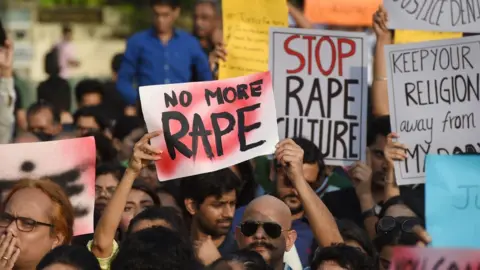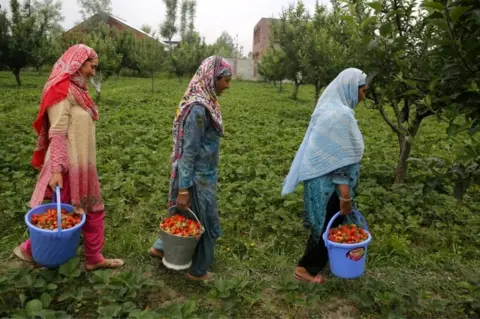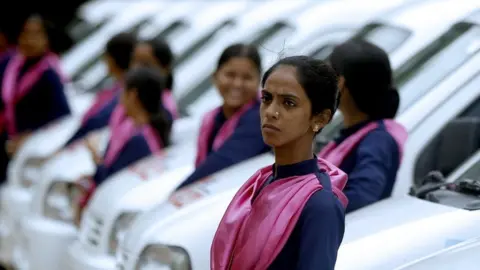Is India really the most dangerous country for women?
 Getty Images
Getty ImagesA survey conducted by the Thomson Reuters Foundation has ranked India as the world's most dangerous country for women, ahead of Afghanistan, Syria and Saudi Arabia. But is this really true?
The poll surveyed 548 experts on six different indices - healthcare, discrimination, cultural traditions, sexual and non-sexual violence, and human trafficking. They were first asked to name the five most dangerous countries from the list of 193 United Nations member states. And then they were asked to name the worst country in each of the above categories. India topped three - cultural traditions, sexual violence and human trafficking.
A similar poll seven years ago had ranked India fourth, with Afghanistan top of the list.
The new survey has been criticised in India, with many questioning how countries like Saudi Arabia and Afghanistan, which grant far fewer rights to women, managed to perform better.
Allow X content?
The country's National Commission for Women rejected it outright, saying that countries where women could not speak out had done better. They also pointed out that rape, harassment and other forms of violence against women appear to have risen in India because more cases are being reported, driven by public outrage.
The Ministry of Women and Child Development said in a statement that using "an opinion poll to peg India as the most dangerous country for women is clearly an effort to malign the nation and draw attention away from real improvements seen in recent years".
How did the report reach this conclusion?
It relies completely on the opinion and verdict of the 548 experts. They include academics, policymakers, journalists and those working in healthcare or other development sectors.
The foundation's head, Monique Villa, told the BBC that 41 of the experts were Indian. However there is no clarity about the nationality of the other experts and how widely other countries were represented. Furthermore, the report states that of 759 experts contacted, only 548 replied - no other information about them is available.
 EPA
EPASanjay Kumar, director of the Centre for the Study of Developing Societies (CSDS), one of India's top independent research organisations, said this "lack of transparency" was extremely worrying. "How were these people chosen? What is the gender divide? Where are they from? This is very important to know, but there is no information available on it," he said.
But Roop Rekha Verma, a college professor and social activist, welcomed the report.
"I am not unhappy about this report and its findings - it is enough to make us sit up," she said. "A better methodology, rooted in intensive data and empirical work, could have been used of course, but if more than 500 gender specialists view it like this, it has to be taken seriously. These aren't perceptions from people on the street - these are well-informed experts."
Was the right methodology used?
No, according to Mr Kumar. He points out that government or other public data is available for many of the parameters used to rank nations, and to ignore that in favour of perception is an "extreme shortcut".
"Data, even if unreliable, should form the basis of any ranking. Perception should form the basis for a ranking only when there is no available data," he said.
Mr Kumar added that the survey admitting to use "mixed methodology" - that is a mix of face-to-face, online and phone interviews - was also very problematic.
"I can tell you from experience that different interview techniques always give you different outcomes. There has to be one base. It seems that in this case the interviews have been carried out on the basis of convenience - one can only assume this as no further explanation is given.
"This is no way to conduct a survey - especially one that you are publicising so much. It's a shortcut and should not be taken seriously."

'India has lost the battle of perception'
Geeta Pandey, BBC News, Delhi
Is India really more dangerous than Afghanistan, Syria or Saudi Arabia?
The government has been quick to question the Reuters survey, but India has no reason to gloat - a look at the official crime statistics for 2016 shows a woman was raped every 13 minutes; six women were gang-raped every day; a bride was murdered for dowry every 69 minutes; and 19 women were attacked with acid every month.
Add to that thousands of reported cases of sexual harassment, stalking, voyeurism and domestic violence.
 AFP
AFPBut despite its considerable flaws, India is a democracy where the rule of law (largely) prevails. As someone who's always lived and worked in India, I know that women enjoy tremendous freedom and rights here and that there really is no comparison with war-torn Afghanistan and Syria, or Saudi Arabia where until a few days ago women could be jailed simply for driving. It's a bit like comparing apples and oranges.
So does this ranking matter? Actually, it does - because it shows India has lost the battle of perceptions. And sometimes, perceptions do matter. So instead of rejecting the survey, India should do some soul-searching to see how it can improve things for its women, convince the world that it's not hostile territory for the female gender and get off lists like these.

Who else is on the list?
Afghanistan and Syria, which have been ravaged by war, come second and third, Somalia is fourth, while Saudi Arabia and Pakistan have been ranked fifth and sixth.
The United States, surprisingly, has been ranked 10th - and it's ranked third for sexual violence.
Allow X content?
Allow X content?
"It's not about the ranking. Our society is ruled by misogyny and patriarchy," Zakia Soman, a women's rights activist who was also one of the experts surveyed, told the BBC.
"We need to take this survey in the correct spirit. We should look at it in a reflective way - where have we gone wrong as a society?"
She added that no-one expects women to have an easy life in countries such as Somalia or Saudi Arabia. But they do expect something more from a democracy like India.
Apples and oranges?
Is it fair to compare India with countries such as Saudi Arabia, where women's rights are restricted?
"It is known that women in Saudi Arabia don't have much access to the public sphere in terms of rights," said Ms Verma. "But the fact that they have made driving legal for women just a few days ago is a sign of hope - to me, it shows that the country is changing and making progress within itself.
"So it is hard to compare that with India, but if we are to look inwards, we see that not much has changed."
But should that be a matter of opinion?
Mr Kumar says a better and more credible method would have been to group countries into categories and rank them within those categories.
